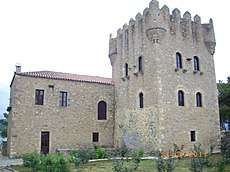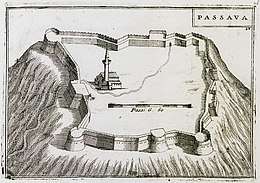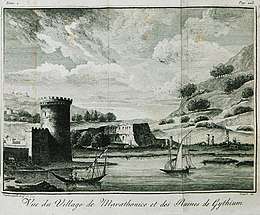Tzanetos Grigorakis
Tzanetos "Kapetanakis" Grigorakis (Greek: Τζανέτος Καπετανάκης Γρηγοράκης; 1742–1813), also known as Zanetos or Tzanibey or Zanibey or Tzanetbey or Zanetbey, was a Greek politician, general[note 1] and the 3rd bey of Mani,[note 2] the most prominent together with Petrobey Mavromichalis.[1] He was the longest-ruled bey of the Maniots, serving for 16 years, from 1782 to 1798.[2]
Tzanetos Grigorakis Τζανέτος Γρηγοράκης | |
|---|---|
| Bey of Mani | |
| In office 1782–1798 | |
| Preceded by | Michalbey Troupakis |
| Succeeded by | Panagiotis Koumoundouros |
| Personal details | |
| Born | 1742 Skoutari, Mani |
| Died | 1813 Mavrovouni, Mani |
| Nationality | Greek |
| Children | Pierros Grigorakis Tzortzakis Grigorakis |
| Father | Demetrios Grigorakis |
| Occupation | politician |
| Family-Party | Grigorakides |
| Military service | |
| Allegiance | |
| Rank | Major (Russian Army) General (Maniot Army) |
| Commands | Commander in Chief of Maniot forces |
Family

Grigorakis was born in 1742 at Skoutari of Gytheio, Laconia, and was member of a famous Maniot's family of Grigorakides, which was a warrior family of local Capetaneoi[note 3]. His father, Demetrios "Kapetanakis" Grigorakis, gave him the name Tzanetos or Tzannis, as the name Ioannis (Ιωάννης, John) is pronounced in Maniot dialect. Tzanetos was the father of Pierros (Πιέρρος, Peter) and Tzortzis (Τζωρτζής, George), or Tzortzakis Grigorakis, who will become the ancestor of the Tzortzakides branch.[note 4] His grandson, and son of Tzortzis, Tzannetakis Grigorakis, will become the ancestor of the Tzannetakides branch.
[1]
Early years
Grigorakis started the military service within his clan, like everybody else in Mani. Later, in Russo-Turkish War of 1768–1774, he appeared in the Ionian Islands, together with Anagnostaras and Christoforos Perraivos, to serve with the rank of major in the Imperial Russian Army forces under the commands of the Greek-Russian general Emmanouil Papadopoulos.[3]
Capture of Passavas

Hassan Ghazi, the ruler of Tripoli, asked the family of Grigorakides to accept that Tzanetos Grigorakis will take over the duties of bey and using the power of their clan to success peace in Mani and their neighboring areas. However, when the Grigorakides rejected his proposal, he proposed Tzanetos Koutifaris as bey of Mani.[4] Hassan Ghazi sent an envoy to Grigorakides family leader, Exarchos Grigorakis, saying that he wanted to negotiate. The men met in Tripoli, but once Exarchos arrived, Hasan Ghazi had him seized and hanged.[5]
When this fact was learned in Skoutari, Tzanetos Grigorakis took over the hegemony as general and to take revenge, he gathered about 3,000 Mainots, campaigning against the Ottomans in the castle of Passava, which captured and slaughtered the 700 families living in and around of it; men, women, children, no one left. After the massacre, he increased the Mani borders at position of Kakoskali, a new border line that the Ottomans never managed to regain.
[6]
Bey of Mani
In 1780, aftermath of the Orlov Revolt and just before the Siege of Kastania, Tzanetos Grigorakis received a message with an envoy from his son-in-law Panagiotaros Venetsanakis and Konstantinos Kolokotronis to send a relief force and avoid the siege, but Grigorakis having a personal rivalry with Panagiotaros, resigned to the fact that they would have to fight alone.[7][8] The refusal of support and assistance to the Kastanian chiefs[note 5] in 1780, objectively served the plans of Kapudan Pasha Hassan, so the Ottoman military leader did not forget it and, in 1782, Tzanetos Grigorakis became the Bey of Mani.[7]
At first, Grigorakis refused to become a bey, but then Dragoman of the Fleet of Ottomans, Nikolaos Mavrogenis, the great-uncle of Manto Mavrogenous and later Prince of Wallachia, came to Gytheio[note 6] and kidnapped him, he also sent as hostages to the Sultan Abdul Hamid I the two sons of Grigorakis and taking him as prisoner to Spetses, where Grigorakis was forced to accept the proposal of Ottomans.[2][5]
Founding of Marathonisi and Mavrovouni
Grigorakis decided to build forts on the border line, occupying all the surrounding areas, renovating the towers or building new ones, and transferring his hegemony from Skoutari to Gytheio, were found Marathonisi, also found a new village on the nearby hill Lykovouni, which it renamed with its old name as Mavrovouni, as well as the new village.[9][10] He also built a tower in Mavrovouni and permanently moved there after 1806.[11][10]
Relationships with Russians
Grigorakis began agreements with the Russians to help him oust the Ottomans from the Peloponnese. In 1787, with the start of the new Russo-Turkish War, Grigorakis tried to strengthen the Russians by activating the Maniates with a letter from the Russian general Dmitry Senyavin.[12]
The Russo-Turkish War termination treaty took place in 1792, but Lambros Katsonis refused to abide by the agreement while hosted in Mani to Achileion, so the Ottomans asked Grigorakis to chase him and arrest him.[13] Katsonis was staying at Grigorakis' house in Mavrovouni, when the Ottomans learned of this and rushed to arrest him.[11] Grigorakis alerted Katsonis to leave and hid his officers and sailors in the villages of Mani, so the Ottomans captured 11 empty ships.[14] After 1792, the Ottomans did not trust Grigorakis, so he decided to build a castle on the hill of Mavrovouni village, in 1795 the castle is finished and named Melissi castle, is also known as Castle of Mavrovouni or Goulades or Beanica or Beanka.[15]
Relationships with French

In 1798, after the departure of the Russians, Grigorakis decided to turn to the French, sending a letter to Napoleon Bonaparte with Demetrio Stefanopoli, writing to him that he would allow the mooring and supply of French ships in Mani.[10] Bonaparte sent a reply letter with Stefanopoli, in which he accepted the agreement.[16][17] Grigorakis sent to Bonaparte his son Pierros Grigorakis, major of the Imperial Russian Army. Pierros fight in Italy, where he distinguished himself and was wounded, but won Bonaparte's regard, who gave secret instructions to Demetrio Stefanopoli to meet all the representatives of the Greek areas, but Grigorakis suggested that Demetrio stay in Mani and safely meet everyone from there. Indeed, it did, and later, in 1801, Grigorakis was supplied with gunpowder by Bonaparte.[16][18]
The Ottomans soon realized that something was wrong and they decided to attack Grigorakis, sending three ships to the port to disembark strong army forces, while at the same time attacking, encircling Mani, with their armies from Mystras and Vardounia. Grigorakis making an extraordinary war council, were Demetrio also participated, and decided to resist with a direct counterattack from many points with small army units.[19] Although he had only 1,000 men at his disposal, the Ottomans suffered heavy casualties and retreated to Mystras and their ships, so the counterattack had a successful result.[20] After this fact, in 1798, the Ottomans had Grigorakis replaced as bey with Panagiotis Koumoundouros.[5]
Demetrio Stefanopoli was thrilled with Grigorakis' strategic skills and the way who Maniot people fought, informing Bonaparte for all these, who agreed to launch a French-Turkish war in the region, but the new bey Koumoundouros did not agree with Grigorakis and the war never lunched.[20]
Last years
In 1803, launched the 2nd Ottoman invasion of Mani, the Melissi castle almost destroyed by cannon balls from the Ottoman fleet, becasuse Grigorakis was supplied again with gunpowder by the Bonaparte,[15] although the supplies were for Zacharias Barbitsiotis.[20] but Grigorakis resisted in the castle of Cranae, which the Ottomans could not demolish, despite the 2,000 cannon balls thrown at there, but before Ottomans retreating, Georgios Voulgaris from Hydra gave them a plan of political victory, after he managed to take by his side the cousin of Tzanetos, Antonis Grigorakis, with the promise to appoint him new bey of Mani.[21]
Right away, the Ottomans accused Koumoundouros of tolerating piracy and suspicious foreign agreements, so replaced him with Antonis Grigorakis, now Antonbey, whom they asked to arrest Tzanetos and Pierros Grigorakis. The Ottoman troops in the area were very large and the local Capetaneoi preferred not to take the risk to attack Antonbey, so Tzanetos fled to Zakynthos to retaliate later. However, the situation worsened when Archbishop Callinicus V and all the dignitaries turned against Grigorakis, even Antonbey, who confiscated the towers and all their property. Pierros came from Paris to Zakynthos with the permission of the Emmanouil Papadopoulos to gather an army under the Russian flag and campaign to Mani. As soon as the Ottomans found out this fact, forgave them both and, in 1806, Tzanetos and Pierros successfully returned to Mani.
[20][21]
In 1813, Tzanetos Grigorakis died in his castle at Mavrovouni village.[1][10]
Notes
- Locally is pronounced Captain (Καπετάν).
- Locally is pronounced Maniotbey (Μανιότ-μπέης).
- Capetaneoi was the Commanders in Chief of Maniot clans.
- Tzortzakides are commonly known as Georgakides or Georgakianoi.
- Kastanian chiefs was are Klephts based in two owned towers at the village Kastania.
- In this historical period Gytheio called Marathonesi.
References
- A Dictionary of Universal Biography, Grigorakis, Tzanetos.
- Mani Org, Tzanetos Grigorakis.
- The History of the Greek People, vol. 11, p. 423.
- Karabinis & Vafas, p. 4.
- Greenhalgh & Eliopoulos, p. 31.
- Karabinis & Vafas, p. 5.
- Mani Org, Kastanitza-Klefturia.
- I. Roumeliotis, Siege of Kastania.
- Karabinis & Vafas, p. 6.
- Great Soviet Encyclopedia, p. 382.
- Karabinis & Vafas, p. 10.
- Karabinis & Vafas, pp. 9–10.
- The History of the Greek People, vol. 11, p. 94.
- The History of the Greek People, vol. 11, p. 95.
- Kastra EU, Goulades castle.
- The History of the Greek People, vol. 11, p. 408.
- Karabinis & Vafas, p. 12.
- Karabinis & Vafas, p. 13.
- The History of the Greek People, vol. 11, p. 409.
- The History of the Greek People, vol. 11, p. 410.
- Karabinis & Vafas, pp. 13–17.
Sources
- "Grigorakis, Tzanetos". A Dictionary of Universal Biography (in Greek). 3. Athens: Ekdotike Athenon. 1983. ISBN 960-213-115-2. Retrieved 8 May 2020.
- "Grēgorakēs". The History of the Greek People (in Greek). 11. Athens: Ekdotike Athenon. 1975. pp. 94–95, 408–410, 423. ISBN 978-960-213-100-8. OCLC 636806977. OL 18546042M.
- "Grēgorakēs 2.". Great Soviet Encyclopedia (in Greek). 8 (3rd: Greek ed.). Athens: Academos. 1978. p. 382. OCLC 5831425.
- Greenhalgh, P. A. L.; Eliopoulos, Edward (1985). Deep into Mani: Journey to the Southern Tip of Greece. London: Faber and Faber. ISBN 0-571-13524-2.
- Karampinis, F. & Vafas, K. (1989) [1858]. "Tzanetmpeus Kapetanakēs Grēgorakēs". Historikai alētheiai symvantōn tinōn tēs Manēs (in Greek). New York: Library of Congress. Retrieved 9 May 2020.CS1 maint: multiple names: authors list (link)
- Roumeliotis, Ioannis (2002). Ηρωίδες της Λακωνίας και της Μάνης Όλης 1453–1944 (in Greek). Areopolis: Adouloti Mani. ISBN 978-960-87030-1-8.
- "Biography of Tzanetos Grigorakis" (in Greek). Mani Org. Retrieved 8 May 2020.
- "Kastanitza-Klefturia" (in Greek). Mani Org. Retrieved 8 May 2020.
- "Goulades castle". Kastra EU. Retrieved 8 May 2020.